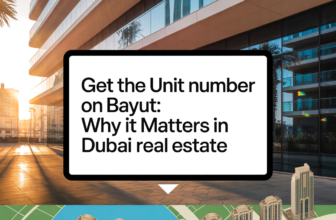
If you’ve ever searched for a property in Dubai using online portals like Property Finder, you know how many listings are available—but often, essential details like unit numbers are hidden or incomplete.
Whether you’re a buyer, tenant, agent, or investor, finding the exact unit number is critical for due diligence, verification, or record-keeping. This is where using a Property Finder unit number finder can save time and boost transparency.
Why Unit Numbers Matter in Real Estate
Knowing the unit number gives you access to:
- Real estate transaction history (via DLD tools)
- Market comparison with similar units in the same building
- Owner verification
- Accurate rental or sale negotiations
- Viewing or inspection scheduling
That’s why many serious users search for ways to find the unit number in Property Finder or other portals when they spot a promising listing.
Why Property Finder Doesn’t Always Show Unit Numbers
Due to privacy rules and platform policies, many listings hide the specific unit number. Instead, they show only:
- Building name or area
- Type (1BHK, 2BHK, villa)
- General floor or view
- Developer/agent name
However, certain tools and tactics can still help you extract or verify the unit number with accuracy.
Methods to Find the Unit Number in Property Finder Listings
1. Use a Unit Number Finder Tool or CRM
Some lead generation and real estate tools (such as thedatabaseleads or CRM-integrated listing tools) are equipped with internal databases that connect phone numbers or listing IDs to actual unit numbers.
If you’re an agent, developer, or investor with access to these systems, you can quickly cross-check listings from Property Finder and identify the exact unit.
2. Reverse-Search the Agent Contact Info
Most listings include agent or brokerage names and numbers. Use these to contact directly and request the unit number, especially if you’re a qualified buyer or client.
Alternatively, you can use DLD’s REST app or Broker Verification tools if the broker is registered.
3. Search on DLD’s Dubai REST Platform
Once you have the building name, area, and possible floor plan, you can use Dubai REST or Oqood to cross-reference with registered transactions and pinpoint likely unit numbers.
4. Check Developer or Community Portals
Some developers like Emaar, Nakheel, or DAMAC allow you to search inventory by tower and view active units for sale or rent—sometimes displaying unit numbers or IDs.
Who Needs to Find Unit Numbers?
- Tenants: To ensure their contract matches what’s advertised
- Buyers: To check price history or RERA valuation for the unit
- Agents: To verify availability before contacting leads
- Investors: To track multiple listings or find off-market deals
Final Thoughts
While Property Finder is a powerful portal for browsing listings, it often lacks detailed data like unit numbers due to privacy or listing limitations. By using a Property Finder unit number finder tool or combining smart research methods, you can quickly identify and verify the unit number behind any property listing in Dubai.
Whether you’re investing, renting, or selling, having full property data helps you make faster, safer, and more confident decisions.





